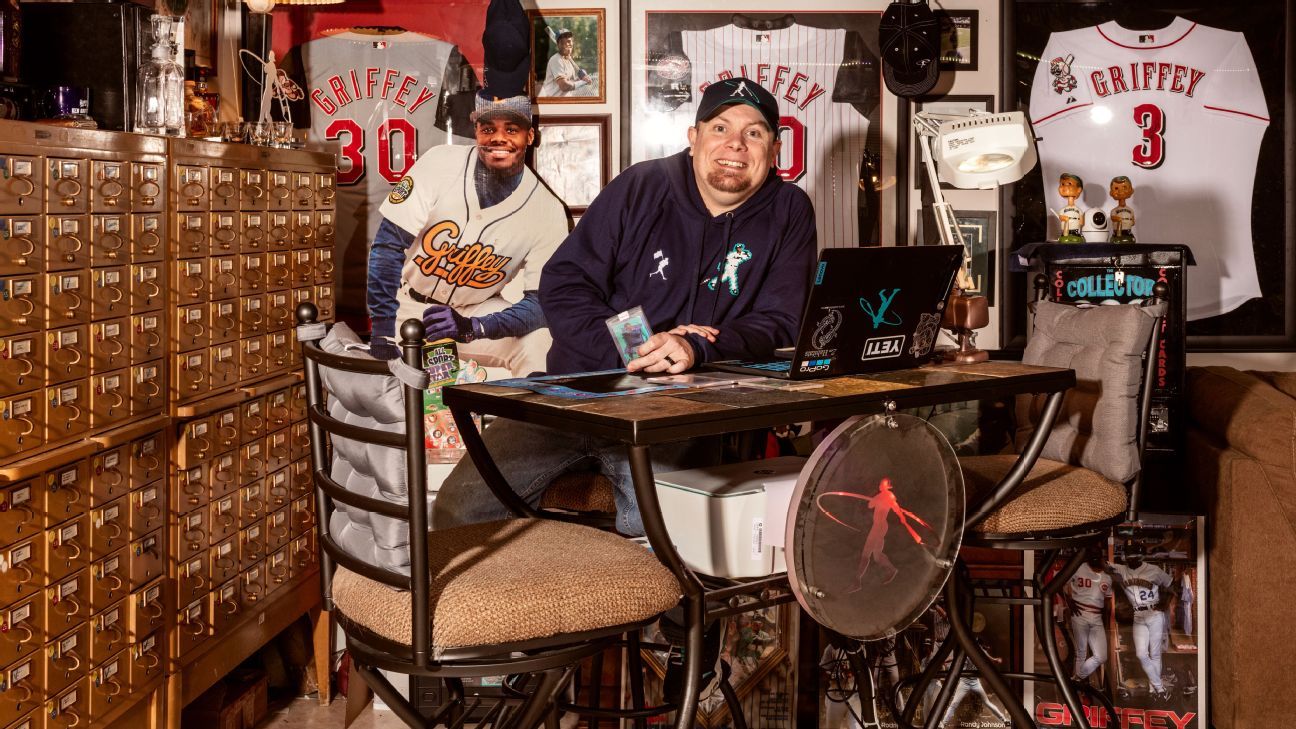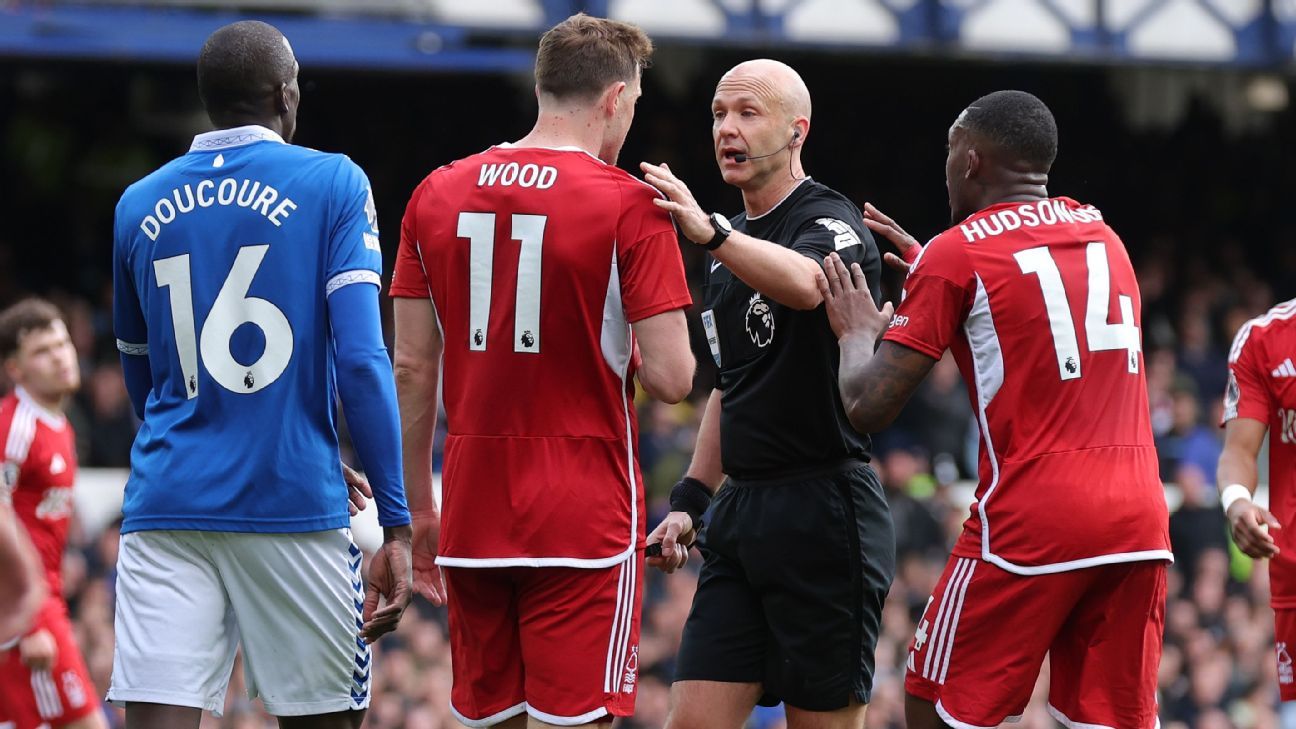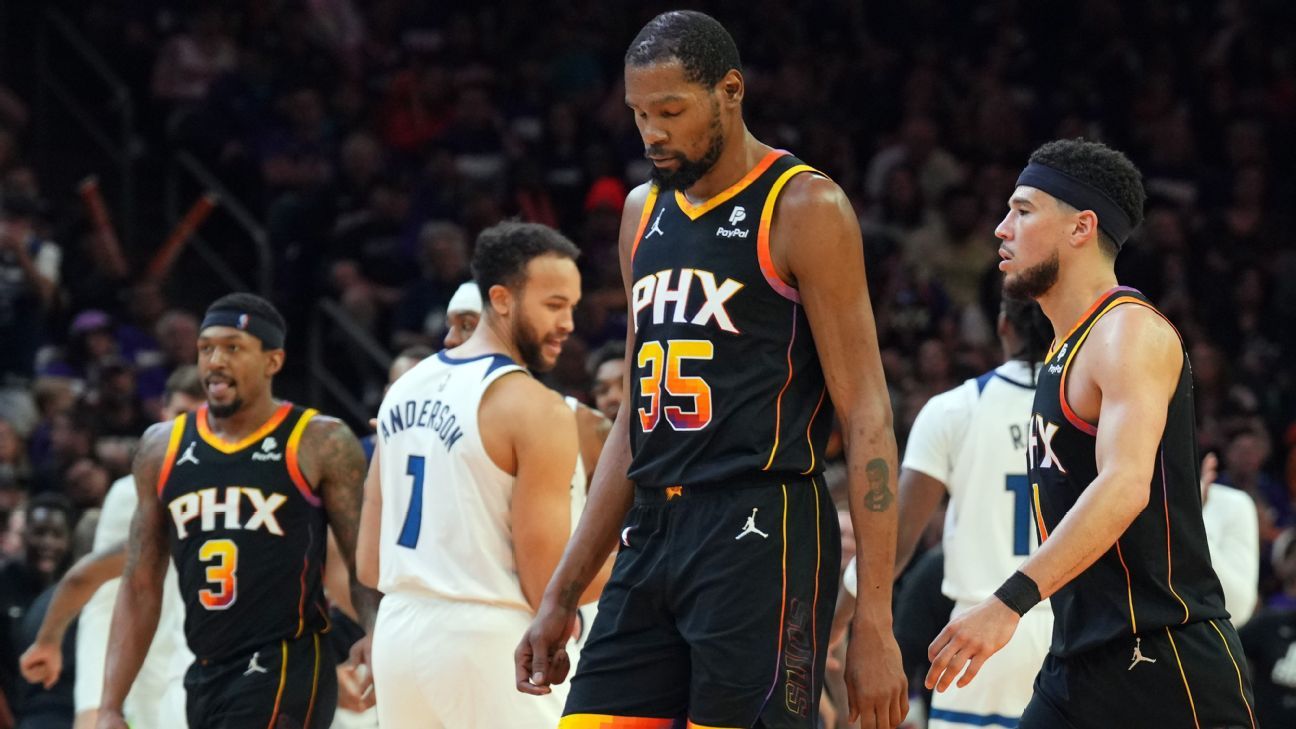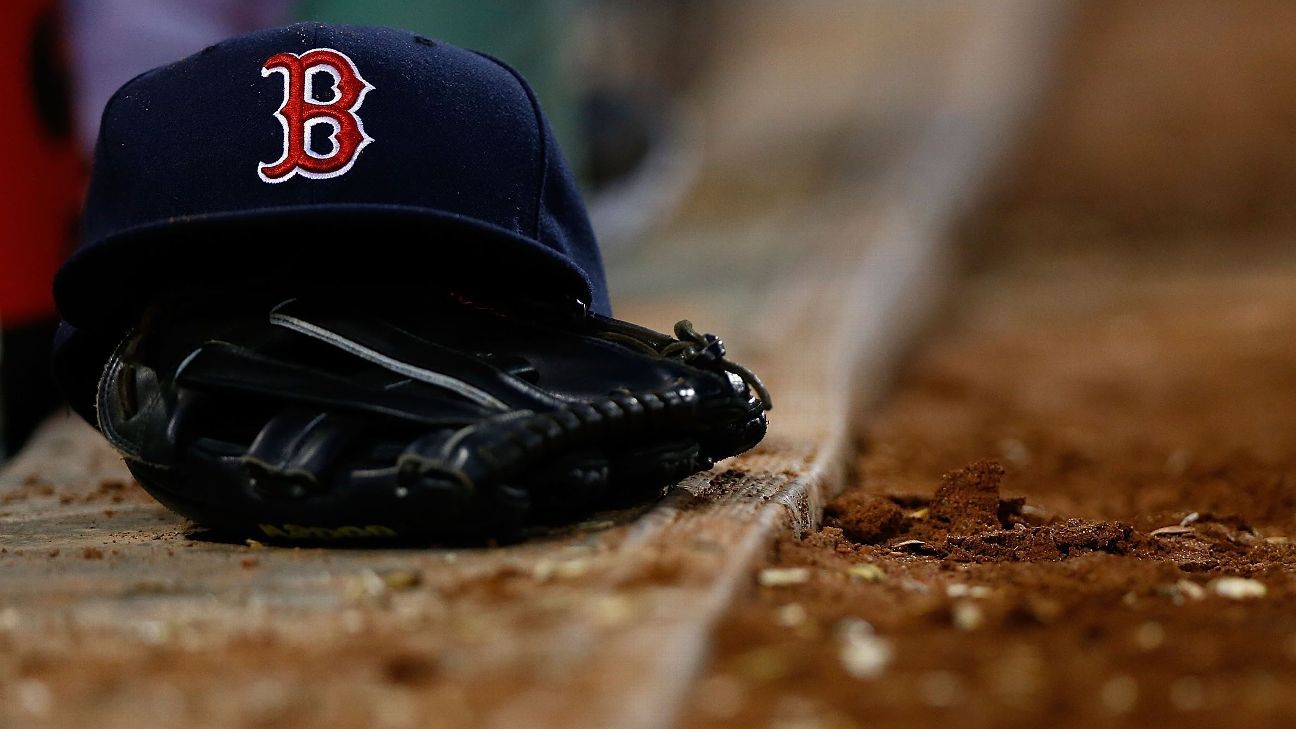
JASON VASS IS WEARING a Ken Griffey Jr. sweatshirt and a Ken Griffey Jr. hat when he opens the front door. He motions to come in and then points toward the bottom of the front stairs, and the official tour of one of the world's largest, life-changing collections of sports memorabilia begins.
Actually, the tour could have started in the driveway, home to Vass' Ford Fusion with a vanity plate saying "GRIFFEY."
Or out back in his shed, where he's storing a rolled-up banner of Griffey that used to hang in the Kingdome. He bought it thinking it was 7 feet long and 6 feet wide... but it turned out to be 17 feet long and 6 feet wide and weighs 100 pounds.
So that's out back of his house in Lynchburg, Virginia, until he figures out what he can do with something the size of a minivan. He's pretty sure the banner was the last straw with his old mailman, who had already been pretty grumpy about the endless stream of packages delivered to Vass' house. "My mailmen are pissed at me on a regular basis," he says.
Vass is 48 years old but bounds inside his house and down the carpeted steps like a teenager. What lies at the bottom of these stairs is more than a collection to him. He has a fast laugh, like a podcast turned to 1.5 speed, and he's giggling as he turns to the left and slowly opens the door. He is walking into his happiest place, unveiling a room that brings him great joy that he thinks might bring you great joy, too.
Vass takes his time with the door like he's showing off the final shot of a home makeover -- this is the big reveal.
Just inside the door, on the floor, lies a giant carpet with a photo of Griffey in a Reds uniform. It's a photo that Vass himself took at a Reds game once, and his wife, Michelle, covertly took the picture to a place that makes personalized carpets.
He works his way around the room, which is 21-feet-by-15 feet, roughly the size of a medium-sized bedroom. He starts on the left, home to a case holding his favorite Griffey items. There are dozens of his most valuable Griffey cards, along with pins, baseballs, photos, a golf hat and a glove that Griffey once used at a charity tournament. There's even a bag of sunflower seeds that Griffey once ate and then autographed. There are two signed footballs from the Cincinnati Jungle Kats, an arena football team that Griffey and former NFL player Sam Adams owned at one point before it went bust.
Two 6-foot Griffey cutouts hang out beside the glass case, like bodyguards, staring directly across the room at what Vass thinks is his most valuable item: The bat that Griffey used to hit home run No. 481. He thinks he could sell it for north of $10,000.
Vass meanders the room in an oval path for 10 minutes, describing as much as he can about how he's accumulated everything. It's impossible to discuss even 20% of the items packed into the room. They're stacked and organized meticulously from the floor to the ceiling, with Griffey-used bats all over the floor, autographed pictures on the walls and Starting Lineup figurines packed on a small shelf running the length of the entire room.
Then he arrives at what is believed to be the single largest collection of sports cards for one player ever assembled. Vass has 101,000 Griffey Jr. cards, ranging from 80 of the infamous 1989 Upper Deck rookie cards to 1,439 of Griffey's 1990 Donruss. "Somebody might have more cards of a single player, but I haven't heard of anybody remotely close to Jason," says Ryan Cracknell, online hobby editor at Beckett Collectibles, the renowned sports card price guide.
Most of the cards are meticulously organized into four library card catalogs, hundreds of duplicate Griffeys, all cloistered together in rows that still have tiny labels at the end saying stuff like "Human ecology-Humanities." The drawers make that gentle squeak of wood sliding on wood as he pulls one after the other out. "Look at whatever you want," he says, waving his hand like a proud chef encouraging everybody to try one of these delicious pumpkin muffins.
He gets a lot of his cards because he's a member of two different Ken Griffey Jr. Facebook groups. Even though he won't say it himself, Vass is something of the Griffey godfather. A buddy runs what could only be classified as the Griffey collector developmental league, where newcomers are welcomed but closely monitored -- only real die-hards are allowed -- and scam artists trying to make a quick buck get a stern talking-to via Messenger. That group has a little more than 1,000 members.
Vass manages the other group, and only the best of the best from the other group get called up to the big leagues. He's the group's unelected president, with the gravitas of a massive collection, the passion of a little kid and an incurable case of Griffey-itis. These are his people, and Griffey is their person.
He ducks his head underneath a film projector hanging down a foot into the middle of the room. He'll come down here some days and project old games or highlight clips of Griffey onto a white screen that unravels on one wall. "This stuff just makes me happy," he says. "It does. I don't know how else to say it."
He's describing how his wife recently located an all-time oddball item on eBay -- a can of Ken Griffey Jr. Easy Cheese -- as he stands in the middle of the Griffey rug. Then he tackles the bigger question: Why?
Why Ken Griffey Jr.?
Why so many cards?
Why?
It's easy to shake your head at a guy like Vass, or scream-watch an episode of "Hoarders" and think, "Geez, just get rid of all that junk, dude!" But the truth is, in a world quickly metaverse-ing into the digital realm, sometimes we still get through stuff -- with stuff. Maybe it's baseball cards, or a wine cellar, or vinyl records, or a family scrapbook, or even just your favorite sweatshirt. But sometimes that pile of crap is the thing that keeps us going."
For the next five minutes, Vass talks about a traumatic childhood, an attempt to take his own life as an adult, a painful divorce and how Ken Griffey Jr. helped pull him through it all, a steady provider of joy amidst a mountain of pain. His rapid-fire speaking pattern slows down for stretches, and he stops talking at others, his lips pursed about an old memory that still hurts.
When he's done talking, it's clear that this room isn't a collection, or even a museum.
It's a monastery.
VASS WAS A CHILD OF DIVORCE and a card collector in the late 1970s and 1980s, which happened to be the intersection of both things exploding to all-time highs in American society.
Divorce rates boomed in the late 1970s and early 1980s, to higher levels than ever before. That's also exactly when card collecting began to morph from a hobby into a business. Topps lost its exclusive deal to print baseball cards in 1980, leading to Donruss and Fleer jumping in the next year. The boom was gradual that decade until Upper Deck changed collecting forever in 1989 with the first high-quality, low-quantity premium card with a splashy first card from its very first set featuring a phenom: Ken Griffey Jr.
As he stands just off to the side of Griffey's face on the carpet, Vass describes a childhood that millions of American 45-year-olds can identify with: divorce. Constant moves. Bad-mouthing by parents. Remarriage, with rocky relationships with step-parents. Divorce again. Throw in puberty and the sometimes brutality of being in high school. He rocks from foot to foot every 60 seconds or so, careful to not ever stomp directly on Griffey's face, and says he's not sure he wants a lot of details in print about the physical and mental abuse he endured as a kid. But that it was torturous and constant. When he mentions that he considers the chaos of his home life to be trauma, Vass says several times that two different doctors have told him that he has PTSD.
Vass desperately wanted to find his tribe amongst his peers. He talks about high school in a grouping way -- that there were the jocks, the geeks, the cool kids, the whatever -- that is both cliché and too simplistic.
But his description also sounds like so many high schools at that time that were full of kids adrift, so unmoored at home that they latched onto football or Drama Club in a way that provided a tethering to something, to somebody. As other kids pondered what they wanted to be when they grew up, Vass was just trying to figure out who to be each morning.
He says he wasn't very athletic or a brainiac, and he'd developed a speech impediment when he had to speak in front of groups. He says he felt like an outcast, wandering from room to room in his life, never quite able to fit in. That led him to spend most of his time with kids using drugs and alcohol to escape similar home lives.
And then one day, when he was 15 or 16, he hung out for an afternoon with two kids, Brad and Aaron, who'd formed their very own startup high school clique: the card collectors. The Griffey Upper Deck card had taken off, fueled by talk that it had been short-printed. It shot to $200 (about $450 in 2022) in mint condition, generating a gold rush at card shops, gas stations and grocery stores. Think "Charlie and the Chocolate Factory," just with wax packs and Griffey cards instead of chocolate bars and golden tickets.
Vass' first valuable card was a 1989 Mark McGwire, and as he says that, he strides across the room and points into the big glass case with all the Griffeys -- he keeps the McGwire in there with his most treasured stuff. Vass despises the steroid era guys -- don't mention the name Barry Bonds around Griffey heads -- but will never forget the world that the McGwire card opened up for him. He was immediately hooked.
Card collecting was so tidy. The cards came in numbered sets, with specific rules about how to grade them, with price guides that provided a specific value. They could be neatly put into protective cases and organized in a way that was meditative for any collector, but especially for rudderless young people. For kids like Vass, who spent every day desperate to fit in, there was something doubly therapeutic about sitting with peers, taking their treasured pieces of cardboard and sliding them into hard cases that would keep them safe. "Collecting Griffey was a game-changer for me," Vass says. "It's still a game-changer."
It wasn't just collecting in general, though. There was something different and special about Griffey for Vass and millions of other young collectors. He was a unicorn athlete, with a story and persona that is almost impossible to replicate. He had the talent of a prodigy, with the name recognition of his baseball father, a smile of pure joy and just enough I'll-wear-my-hat-backwards-if-I-please rebelliousness, all packed into one 19-year-old person. "Griffey was a cultural phenomenon, beyond just being a great player," Cracknell says. "He brought so much joy to a game that can be pretty stuffy, and his Upper Deck rookie changed the hobby forever. It elevated sports cards to an entirely different level."
Vass' basement is a shrine to Griffey, and also how the late 1980s capitalistic greed led to the eventual collapse of the collectibles industry five years later. There was too much, too fast, and Griffey was the poster-child: Vass says Griffey had 21,000 different cards printed with his face on them over his 22-year career (Vass "only" has 8,629 of them), to go along with the figurines, bats, pins, cereal boxes, wine bottles and umpteen other items that slapped Griffey on them.
But the figurative card industry bubble never burst for Vass or many other Griffey collectors even as actual values dropped to almost nothing. Vass had found a lifelong life raft to hang onto, and he'd found his people, too. Vass spent the rest of high school collecting and hanging out with collectors. He got a job at a local company, Alliance Industrial Corp., which made conveyor belt equipment and systems and worked his way up gradually over the years. He moved around a few times, and with every move, he boxed up his Griffey stuff and took it all with him.
Eventually, he found love and got married. But a few years into marriage, his wife asked him for a divorce. Vass was devastated -- they didn't have any kids together, but he'd always vowed to not end up like his parents. And here he was, getting divorced.
One night, Vass was in particular pain contemplating moving out when his wife went to the gym and left Vass home alone. He'd left a good job at Alliance to move with her closer to Washington, D.C. Now, Vass felt like that little kid from 20 years earlier, a scared rudderless kid in a 35-year-old man's body. He remembers pouring a bottle of Xanax and a bottle of aspirin into his hand. He stared at the pills, then shrugged and swallowed them all.
"It wasn't just my marriage," he says. "It was the divorce, plus losing my career, plus the PTSD I went through as a kid. There were so many things that had gone wrong that it came to a head."
As Vass tells this part of his story, he sits down in the corner of his basement at what he calls his logging area. It's a stool with a seat back, at a desk with a jeweler's lamp above it. This is the safest place in the world for him, nestled in the back corner of his Griffey room. He comes down here after rough days, flips open his laptop and starts logging every new Griffey item he has.
For Vass, it's a spot that feels like a blanket that just came out of the dryer. His voice had trailed off a bit a minute ago, but there's a steadiness that comes over him once he's anchored in the chair. The world seems okay when he is looking at it from this seat.
He woke up a week later from a coma, and his doctor told him his soon-to-be-ex-wife had found him unconscious, called paramedics and had him rushed to the hospital. He says his doctor told him he'd been dead for 93 seconds at one point before he'd been resuscitated. "Look right here," Vass says, pointing to the inside of his nostril. "This is where the feeding tube had been. It really did a number on my nose."
He stayed in the hospital for another week. When he got out, he had to move out of his house as his divorce was finalized. He found himself living in his dad's guest bedroom, surrounded by box after box of Griffey memorabilia. He was 35 years old, divorced, starting over after trying to take his own life.
When he felt better a few weeks later, he told his friends and family that he was going camping, by himself. "Everybody freaked out at first," Vass says. "They thought I might not come back. But at that point, I just needed to go out there and try to find myself."
Eventually, he persuaded his dad he had to do this, and Vass started packing his bags. He took a tent, rope, pots and pans, a hammock, some food and water and a small hunting knife. "I wanted it to be so that I was forced to live inside my head and figure things out," he says.
On the day he decided to leave, he loaded his stuff into the car and grabbed one more thing for the trip, something he thought might help him work through all of his stuff: a 1989 Upper Deck Griffey Jr. "I wanted that by my side as I tried to get my life back on track," he says.
For the next two weeks, Vass was by himself in the woods. Vass speaks a little slower as he tells this story from his logging stool, but then he speeds up. He's happy to talk about the healing that happened out there. He says he cried, he prayed, he cried some more and when he says he punched a few trees, he puts his fists up and starts swinging them like he's back punching the trees. And damned if he didn't reboot himself out there in the woods, cooking over a fire, listening to birds, staring at a baseball card.
He came back to his dad's house feeling like a new middle-aged man. He decided to reapply at Alliance, and he got the job as a designer and salesman for conveyor belts that the company sells to some of the nation's largest food and drink manufacturers. Vass eventually moved out, lugging all of the Griffey boxes with him, and met someone. He asked her out to Buffalo Wild Wings and bowling, and Jason and Michelle Vass have been together ever since.
He chuckles a bit with his fast laugh when he's asked about the moment he first told Michelle about The Thing He Does In The Basement. It was two months into dating, and they were discussing how well their relationship had been going and where they might want to live if they ever decided to move in with each other. They settled on him moving in with her and her two kids at their house.
"Uh, Michelle, if we're going to live together at your house, I feel like I should tell you something about me," he told her. "Something you have a right to know about. I have this thing that I like to do..."
She got a worried look on her face, realizing the number of deal breakers that could fill out the end of that sentence. But Vass explained what Griffey had meant to him during the roughest patches of his life, that the collection was massive and sometimes all-consuming, that it was his version of meditating, or going to the gym, or fixing up old cars, or gardening. "I told her this is a part of who I am," he says, and then he lets out another laugh. "Of course, I don't think she understood the gravity of it until I went to display it."
When he moved in a few months later, he carried box after box of Griffey stuff inside. Vass wasn't even halfway through bringing everything inside when Michelle saw the growing mound.
"You weren't kidding, huh?" she asked. "You don't think this is a problem at all?"
"No," he gently said. "It makes me really happy."
She nodded her head, and a few months later, they made it official. "I married Jason," she jokes now, "and I got Ken Griffey Jr. too."
FOR MANY YEARS, Vass told people something he actually believed -- that if he ever got to shake Ken Griffey Jr.'s hand, he'd be able to stop adding new stuff. "Then I could be done with this," he says.
He says that, then gets a sheepish look on his face as he pulls up his favorite photo. It's a shot of him, three feet away from Griffey Jr. on the day the Reds inducted him into their team Hall of Fame in 2014. Vass had posed for a quick shot, then leaned in and said quickly, "Thank you for what you've done for my life and thank you for what you've done for baseball."
Then they shook hands, which was supposed to be the perfect ending to his Griffey Jr. collection. "It kind of got worse after that," Vass admits.
The Facebook pages played a big part in that. The same way those two kids in high school, Brad and Aaron, had helped him fit in as a teenager, this online crew had become members of his inner circle in his 40s. Everybody shares the joys of Griffey, for sure, but it's become a safe haven for super collectors to convene and talk about life. This is therapy for them.
They share their struggles and comebacks, and Vass couldn't live without it. On the day Russia invaded Ukraine, Vass exchanged supportive texts with his Facebook friend Denis, who makes and sells Griffey Jr. nesting dolls that sit on a prominent shelf in Vass' basement.
Vass counts Matt Posman, a Griffey collector from Downingtown, Pennsylvania, as one of his best friends -- even though the two have yet to meet in person. They congregate on the Griffey super collectors' page and text and call each other almost every week, their ups and downs now extending far beyond their collections.
Like Vass, during difficult times in his life, Posman has turned toward collecting Griffeys as a way to find his footing. When he graduated Penn State with a math degree in 1999, he found himself trying to figure out what adulthood would look like for him, while also trying to reconcile what a bummer it was that he'd sold off most of his Griffeys. "For beer money," he says now, with a hint of venom for himself. Just during Posman's time at college, Griffey had ripped off one of the great four-year runs in MLB history, with 209 home runs, 567 RBIs and four Gold Gloves in center field.
So he dove back in, focusing almost entirely on Griffey. He joined Vass' Facebook group seven or eight years ago, and the two have become good friends since. Posman's wife is very supportive, but also enjoys needling him a bit. She'll come into the room while Posman and Vass are yapping on the phone about Griffey memorabilia, and she'll say, "Are we talking about the collection?" dropping voice down for the last two words as she waves her hand like a Jedi convincing a storm trooper to move along.
Vass is hoping they can get together in person someday soon, and it's possible Vass holds a Second Annual Ken Griffey Jr. Facebook get-together in real life. The first one took place in 2016 in Cooperstown, New York, when Griffey Jr. was inducted into the Baseball Hall of Fame.
That had been an epic moment for about 20 of the world's foremost Griffey heads. Everything they owned saw a surge in value and interest with Griffey's Hall election, and the two Facebook groups were electric for the months leading up to his induction.
For the occasion, Vass decided to make his own set of Ken Griffey Jr. cards. He's a gifted metal worker, and he made 20 heavy silver Griffey cards, numbering each one and handing them out to all the Facebook friends who showed up in Cooperstown. "We all hung out for those three days, and it was one of the greatest times in my life," Vass says. "I can't wait to do it again."
TOWARD THE END OF THE TOUR, Vass is sitting at his logging table in front of his spreadsheet. He points back at a chest on the ground behind him, full of stuff that either needs to be logged or has been logged but doesn't quite yet rate enough to be on display. He's staring at his screen when he casually mentions that he has two of Ken Griffey's suits in there, unopened.
Suits?
"Yeah, they were custom-made suits of his from a couple of events in the 90s," he says. "I never even opened them up because I don't know how I would display them. And even if I figured out how to display them, I think it'd be ... creepy."
He redirects his attention to his laptop and the spreadsheet where he recently logged the two suits, which cost $200 apiece. Every single item he owns is carefully recorded there, with a field for value. About five years ago, Vass took out an insurance policy, for $55 per month, on his Griffey collection, so he closely monitors and updates how much everything is worth.
Well ... how much is everything worth? Vass doesn't answer right away, but finally points to the grand total on the page and says, "Here's what I estimate its value at."
The number: $421,000.
That dollar figure goes up almost every single day. After some initial reluctance on move-in day, Michelle has grown to be all-in on his Griffey collection. Her greatest contribution is the carpet on the floor. But the bigger thing she's done, the thing that causes Vass to mist up a bit as he contemplates, is her acceptance of the importance of this room for Vass.
He needed it when he was a little boy, and he needed it as a teenager, and he needed it as a 35-year-old, and he needs it now.
He loves his job but it's stressful. He designs and sells complex conveyor systems that do incredible mechanical things, like fill and cap 1,500 Coke cans per minute. He sits at his laptop and plays videos of the canning process like an NFL ref under the replay hood, slowing them down, rewinding, playing again, to try to show how one little mistake on his part can cause a devastating loss in a very short time. He was at a plant once when an operator sped up the belt too much, a few thousand soda cans backed up and then exploded... The whole thing was over in two minutes, and it took the company 48 hours to tear everything apart, clean it and replace destroyed equipment. "I wouldn't say I can make multimillion-dollar mistakes," he says. "But I could definitely mess up something that is a million-dollar mistake."
He'll often come home, collect Griffey packages from the front step, wave to Michelle on the way in and say, "I gotta go log some." He'll take a deep breath and slide into his chair, and the pressures of the day slowly dissipate.
"My Griffey collection ... it saved my life," he says. "It really did."
He pauses for a second and gets a mischievous look on his face.
"You know what? Screw it, let's open up those suits," he says, and he reaches down into the chest and lifts out two unopened rectangular priority mailboxes.
"God, I feel odd," he says.
He slices open the lid, and there is a single slice of bubble wrap, and then... the suit. He unfolds it carefully, first the coat, then the undershirt, then the pants. It's as crinkly as you'd expect for a suit that has probably been boxed up for 20 years. He flips over the tag from the inside of the shirt's sleeve, and it says "Custom apparel, Ken Griffey Jr. 4/10/1999." He hangs the tannish jacket over the back of the stool he always sits on, then plops down the white undershirt on top of it, then finally the pants.
It's quite a sight: It looks like a magician made Ken Griffey Jr. disappear, and the only thing left was his deflated suit.
"Okay, this actually is a little creepy," Vass says, with a laugh.
In truth, nothing about Vass and his collection actually feels creepy. Obsessive? Yes. Excessive? For sure. But creepy? Nah. Any time somebody describes very real, very deep pain, the kind that would make anybody think, "I've been through some stuff ... but I don't know if I could handle what that guy just described," who can fault him then when he describes the antidote for their trauma and it happens to be a ton of baseball cards? Have at it, Jason Vass.
He cuts open the second box, and it's virtually identical except for the color -- this time it's a black suit jacket, white undershirt, black pants and an initialed tag that says "KGJ." Vass lays out the suit on top of the first one, and now it looks like two Ken Griffey Jr.'s have disappeared.
A half-hour later, the suits are still laying there, deflated, when Vass walks toward the basement door, over the carpet with his picture of Ken Griffey Jr. on it, past the table he made with Ken Griffey Jr.'s swing carved into it and the Ken Griffey Jr. soda machine, and he says farewell. He's still thinking about those old suits.
He looks back over his shoulder and says, "What the hell am I going to do with these?" he wonders.
It's not a throwaway question. This room, and the items that line its walls, is a living organism for Vass, a place that can be revamped and reorganized and refreshed any time he wants, to help him transform a physical space into a place that helps him transform his mood.
He starts to talk about the layout of the room and where the suits fit in, and it's like hearing a museum director pour out his or her brain.
"The last thing I want people to think is that I'm weird and creepy because I'm not," he says, staring at the suits. "I don't even know how to display them. It might be too weird."
He gets into a kind of thinking man pose, with his thumb and index finger gripping his chin as he looks at the suits. "They'll be kind of strange in here but..."
He stops talking for a beat. He shakes his head and laughs because The Thing He Does In The Basement just got 10% more odd -- and beautiful.
"You know what, though? They're pretty badass," Vass says. "Really badass. They're going to fit in real nice down here."
If you or someone you know is having thoughts of suicide or struggling with mental health issues, call the National Suicide Prevention Lifeline at (800) 273-TALK (8255) or visit suicidepreventionlifeline.org.















 Phone: (800) 737. 6040
Phone: (800) 737. 6040 Fax: (800) 825 5558
Fax: (800) 825 5558 Website:
Website:  Email:
Email: 






